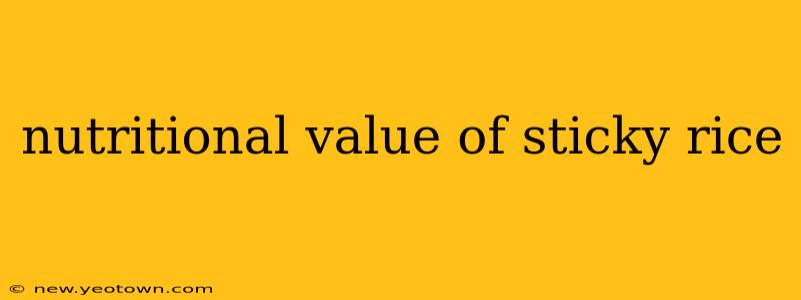Sticky rice, also known as sweet rice or glutinous rice, holds a special place in many cultures, gracing tables from celebratory feasts to everyday meals. But beyond its delightful texture and versatility, what's the real nutritional story behind this beloved grain? Let's delve into the nutritional value of sticky rice, exploring its benefits and potential drawbacks.
What are the main nutrients in sticky rice?
Sticky rice, unlike its long-grain counterpart, boasts a higher concentration of amylopectin, a type of starch that gives it that characteristic stickiness. While this impacts its texture, it also influences its nutritional profile. A cooked cup (150g) of sticky rice generally provides around:
- Calories: Approximately 200-220 calories. It's a moderate source of energy.
- Carbohydrates: The primary macronutrient, providing roughly 45-50 grams. This makes it a significant source of energy.
- Protein: A relatively modest amount, around 3-4 grams per cup. Not a primary protein source.
- Fiber: Sticky rice contains a moderate amount of fiber, contributing to digestive health. The exact amount varies based on the type and processing.
- Vitamins and Minerals: It offers smaller amounts of various vitamins and minerals, including thiamin (B1), niacin (B3), iron, and magnesium. However, these quantities aren't exceptionally high.
Is sticky rice healthy?
The healthfulness of sticky rice, like any food, depends on context. It's not a "superfood," but it can certainly be part of a balanced diet. The high carbohydrate content provides energy, essential for physical activity and overall bodily functions. The fiber contributes to digestive regularity and helps promote feelings of fullness. However, the relatively low protein and fiber content compared to other grains mean it shouldn't be the sole staple of a diet.
How does sticky rice compare to other types of rice?
Compared to brown rice or wild rice, sticky rice generally offers less fiber and fewer micronutrients. Brown rice, for example, is a whole grain, retaining the bran and germ, which are rich in fiber, vitamins, and minerals. Wild rice, similarly, is nutritionally denser. However, sticky rice's unique texture and flavor make it a beloved ingredient in many cuisines.
Is sticky rice good for weight loss?
Due to its high carbohydrate content, sticky rice isn't typically considered ideal for weight loss diets. While it does contain some fiber, the overall glycemic index is relatively high, meaning it can cause a rapid spike in blood sugar levels. This can lead to increased insulin production and subsequent fat storage. Moderation is key if you're watching your weight.
What are the potential downsides of eating too much sticky rice?
Consuming excessive amounts of sticky rice can lead to several potential downsides:
- Weight gain: As mentioned, the high carbohydrate content and glycemic index can contribute to weight gain if not balanced with other foods and sufficient exercise.
- Blood sugar spikes: The rapid rise in blood sugar can be problematic for individuals with diabetes or insulin resistance.
- Nutrient deficiencies: If sticky rice makes up a significant portion of your diet, it may lead to deficiencies in certain vitamins and minerals if not complemented by a variety of other nutrient-rich foods.
How can I incorporate sticky rice into a healthy diet?
To maximize the benefits and minimize the downsides of sticky rice, consider these strategies:
- Pair it with protein and healthy fats: Combining sticky rice with lean protein sources (like chicken, fish, or tofu) and healthy fats (like avocado or nuts) helps to slow down digestion, stabilize blood sugar, and increase satiety.
- Choose whole-grain options: While true "whole-grain sticky rice" is less common, opting for minimally processed varieties can slightly improve the nutritional profile.
- Practice moderation: Don't make sticky rice the cornerstone of your diet. Incorporate it as one component of a balanced meal plan that includes plenty of fruits, vegetables, whole grains, and lean proteins.
In conclusion, sticky rice offers a unique culinary experience, but its nutritional value is moderate. By understanding its composition and making informed choices about its consumption, you can enjoy its deliciousness without compromising your overall health. Remember, a varied and balanced diet remains the key to optimal well-being.

